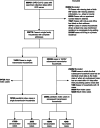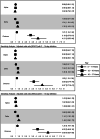Association between age of paediatric index cases and household SARS-CoV-2 transmission
- PMID: 39563607
- PMCID: PMC11626455
- DOI: 10.1017/S0950268824000918
Association between age of paediatric index cases and household SARS-CoV-2 transmission
Abstract
SARS-CoV-2 transmission dynamics within households involving children are complex. We examined the association between paediatric index case (PIC) age and subsequent household SARS-CoV-2 transmission among cases reported to the Minnesota Department of Health between March 2021 and February 2022. In our primary analysis, we used logistic regression to estimate odds ratios adjusted for race/ethnicity, sex, geographic region, and disease severity among households with an unvaccinated PIC. We performed a secondary analysis among households where the PIC was eligible for vaccination adjusting for the same covariates plus time since the last vaccination. Both analyses were stratified by variant wave. During the Alpha wave, PICs of all age groups had similar odds of subsequent transmission. During Delta and Omicron waves, PICs aged 16-17 had higher odds of subsequent transmission than PICs aged 0-4 (Delta OR, 1.32; [95% CI, 1.16-1.51], Omicron OR, 4.21; [95% CI, 3.25-5.45]). In the secondary analysis, unvaccinated PICs had higher odds of subsequent transmission than vaccinated PICs (Delta OR 2.89 [95% CI, 2.18-3.84], Omicron OR 1.35 [95% CI, 1.21-1.50]). Enhanced preventative measures, especially for 12-17-year-olds, may limit SARS-CoV-2 transmission within households involving children.
Keywords: COVID-19; SARS-CoV-2 transmission; households; paediatric; regression analysis.
Conflict of interest statement
The authors declare none.
Figures




Similar articles
-
Factors Associated With Transmission Across Three Waves of SARS-CoV-2 in a Prospective Community-Based Study of Households With School-Aged Children-Dane County, Wisconsin, 2020-2022.Influenza Other Respir Viruses. 2024 Nov;18(11):e70031. doi: 10.1111/irv.70031. Influenza Other Respir Viruses. 2024. PMID: 39478308 Free PMC article.
-
Pediatric and Young Adult Household Transmission of the Initial Waves of SARS-CoV-2 in the United States: Administrative Claims Study.J Med Internet Res. 2024 Jan 4;26:e44249. doi: 10.2196/44249. J Med Internet Res. 2024. PMID: 37967280 Free PMC article.
-
Household transmission of SARS-CoV-2 and risk factors for susceptibility and infectivity in Wuhan: a retrospective observational study.Lancet Infect Dis. 2021 May;21(5):617-628. doi: 10.1016/S1473-3099(20)30981-6. Epub 2021 Jan 18. Lancet Infect Dis. 2021. PMID: 33476567 Free PMC article.
-
Factors Associated With Household Transmission of SARS-CoV-2: An Updated Systematic Review and Meta-analysis.JAMA Netw Open. 2021 Aug 2;4(8):e2122240. doi: 10.1001/jamanetworkopen.2021.22240. JAMA Netw Open. 2021. PMID: 34448865 Free PMC article.
-
Household Transmission of SARS-CoV-2: A Systematic Review and Meta-analysis.JAMA Netw Open. 2020 Dec 1;3(12):e2031756. doi: 10.1001/jamanetworkopen.2020.31756. JAMA Netw Open. 2020. PMID: 33315116 Free PMC article.
References
MeSH terms
Supplementary concepts
LinkOut - more resources
Full Text Sources
Medical
Miscellaneous

